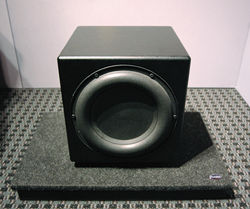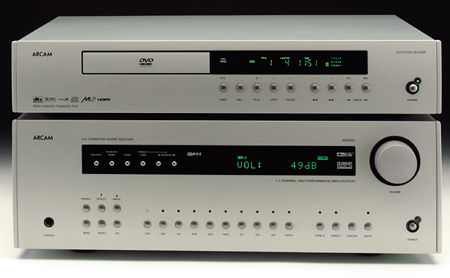| Columns Retired Columns & Blogs |
Music in the Round #9
With the new power and furniture arrangements in my multichannel room, I've begun to reexamine all the other things that affect system performance, including power conditioning and signal cables. However, I could not get my wife to accept the presence in that room of an ASC Sub Trap, which lifted my Paradigm Servo-15 subwoofer to eye level. Not that I protested the Trap's departure all that much—at that height, Trap and sub partly blocked direct radiation from my rear left speaker. But I felt its absence immediately, as my system returned to the usual somewhat boomy, overly punchy bass. The ASC left me with the determination to deal with room problems, particularly in the bass.
My next attempt (with more serious room treatments yet to come) was with a pair of Auralex SubDudes. The SubDude is derived from Auralex's Gramma, which was made to provide isolation for large guitar amps and bass cabinets that might, at concert locations, have to be placed on springy, resonant supports or stages. However, as the Gramma has became popular in some home theater circles as a simple and inexpensive ($59) support for subwoofers and other floor-mounted speakers, Auralex decided to offer a less garishly styled version for the home.
 The SubDude is an MDF platform 23" long by 15" wide by 2.75" high, covered with a carpet of thick felt and supported by two risers of PlatFoam, a high-density isolation pad. Between the risers, the SubDude's underside is lined with 1" Studiofoam Wedges to damp the partly enclosed cavity. Each SubDude has a rated load capacity of 300 lbs. While my Paradigm Servo-15 weighs only (!) 90 lbs, I used two SubDudes under it in order to span the sub's four widely spaced feet. I also tried using only one 'Dude; while the performance sounded the same, the sub looked strange floating there with no visible means of support.
The SubDude is an MDF platform 23" long by 15" wide by 2.75" high, covered with a carpet of thick felt and supported by two risers of PlatFoam, a high-density isolation pad. Between the risers, the SubDude's underside is lined with 1" Studiofoam Wedges to damp the partly enclosed cavity. Each SubDude has a rated load capacity of 300 lbs. While my Paradigm Servo-15 weighs only (!) 90 lbs, I used two SubDudes under it in order to span the sub's four widely spaced feet. I also tried using only one 'Dude; while the performance sounded the same, the sub looked strange floating there with no visible means of support.
The SubDudes did their job as advertised. They significantly isolated the Servo-15 from the live wooden floor, making the sound tighter and fuller but, conversely, less obtrusive, even at the high levels encouraged by the Saint-Sa;dens "Organ" Symphony! In fact, the SubDudes had this capability when placed under any of the full-range speakers with which I tried them. Because I run the front-channel Paradigm Studio/60s full-range most of the time, putting one SubDude under each did the same trick for their bass performance as they had for the sub's. One caveat: Simply as a consequence of raising the tweeter axis nearly 3", the SubDude will also affect high-frequency performance. In my case, that meant it was a little higher than optimum for the Studio/60 v3s, but just right for the slightly shorter Studio/60 v.2s.
 Is the SubDude an effective replacement for the SubTrap? Unfortunately, no. It does not raise the bass driver sufficiently to get it out of the pressure zone near the floor boundary, and its small trapped space is insufficient to significantly affect any fundamental room mode. But both of these problems can be dealt with in other ways; otherwise, the Sub-Trap is an almost complete acoustic solution, if you can live with it.
Is the SubDude an effective replacement for the SubTrap? Unfortunately, no. It does not raise the bass driver sufficiently to get it out of the pressure zone near the floor boundary, and its small trapped space is insufficient to significantly affect any fundamental room mode. But both of these problems can be dealt with in other ways; otherwise, the Sub-Trap is an almost complete acoustic solution, if you can live with it.
Other room treatments, and even electronic equalization, can be enlisted to assist the SubDudes. On the other hand, the SubDudes do their single, simple job right. Because I had only two (gotta get some more), I have not yet been able to completely Auralize all of my speakers. But, like the ubiquitous Vibrapods for electronics, I intend to use them everywhere I can!
Not a universal player
There seems to be an underlying presumption that universal disc players—by which I mean those that play the CD, DVD-Video, DVD-Audio, and SACD formats—must compromise one function in favor of another. I don't buy that. From the Linn Unidisk 1.1 to the Denon DV-5900 and Marantz DV8400, there are universal players that, within their market niche, handle all formats with aplomb. Still, there's something to be said for the commitment to a single medium, and especially for the uncompromised implementation of that commitment. Arcam's John Dawson makes no bones about Arcam's preference for DVD-Audio over SACD as the preferred medium for discrete multichannel music, and offers the DV-79 DVD-A player ($1795) as proof (footnote 1).
Compared, even on paper, to the familiar chipsets and busy front panels of most American and Asian players, the Arcam DV-79 is a breath of fresh air. Its gray panel and single tier of buttons contrast with the usual black-on-black or silver-on-silver fronts. (The DV-79 is also available in silver, but the design simplicity is retained.) That said, mainstream players better differentiate their controls for the visual and tactile senses; the size and uniformity of the Arcam's function buttons requires one to read some rather small labels. Still, one tends these days to use the front-panel controls for little other than Load and/or Play, and to rely on the remote and onscreen display (OSD) for everything else. The DV-79's remote operation in these areas is well-arranged and convenient.

There's a wide, bright display panel above the control buttons, a single disc tray to the left. On the rear panel, in addition to power input and voltage selection, the DV-79 has eight analog audio outputs (front L/R are duplicated), coax, and TosLink digital audio outputs, and a full array of video outputs: composite, component, S-video, the European SCART, and High Definition Multimedia Interface (HDMI). The last two are really A/V outputs; HDMI is important for audiophiles as well as videophiles. HDMI supports digital video and audio with stereo and, soon, multichannel sound in one connector, and is beginning to appear on many new products.
While I was able to successfully use the HDMI output for really superb video, I had no audio device with an HDMI input. But mark my words—HDMI, which incorporates High-bandwidth Digital Content Protection (HDCP), will be increasingly important in the future; the content protection it offers makes it a format that content providers will support. Look for it on newer A/V devices and, eventually, in high-end digital audio systems.
Under the hood, the Arcam DV-79 uses a 32-bit Zoran audio DSP. In tandem with Arcam's customized functions and menus, this provides one of the most comprehensive OSD setup facilities that I have so far used in a DVD player. This includes setup for the Dolby Digital and DTS decoders and full Dolby Pro Logic II capabilities, with Dimension and Center-Width controls. Bass management is applicable to all formats, including DVD-A, and permits separate Large vs Small settings for the front, center, and surround channels, bass redirection to the fronts and/or sub, a bass crossover adjustable from 50 to 150Hz in 10Hz increments, and individual channel-level and time-delay settings, the last calibrated in feet or meters, not milliseconds! Arcam's sophisticated, ultra-low-jitter clocking, and a 24-bit/192kHz Wolfson WM8740 DAC for each of its six channels, result in high-quality analog output for all formats, including HDCD.
Footnote 1: Arcam, Pembroke Avenue, Waterbeach, Cambridge CB5 9PB, England, UK. Tel: (44) (0)1223-203200. Fax: (44) (0)1223-863386. Web: www.arcam.co.uk. US distributor: Audiophile Systems Ltd., 8709 Castle Park Drive, Indianapolis, IN 46256. Tel: (888) 272-2658 (toll-free), (317) 849-5880. Fax: (317) 841-4107. Web: www.audiophilesystems.com.
- Log in or register to post comments




































